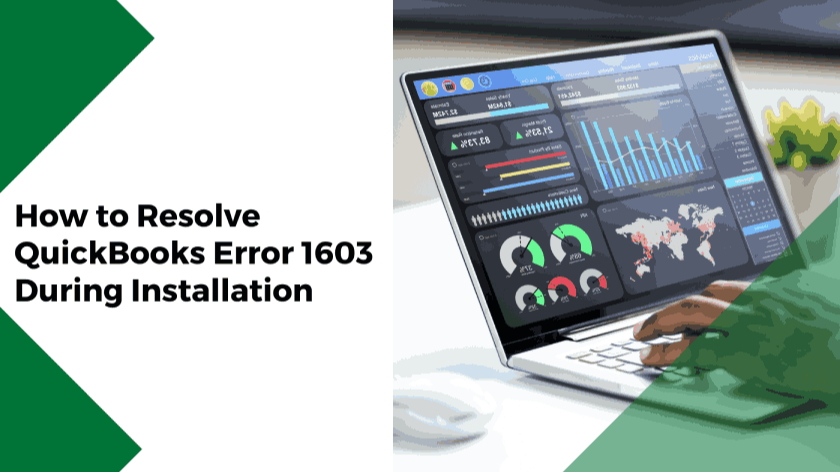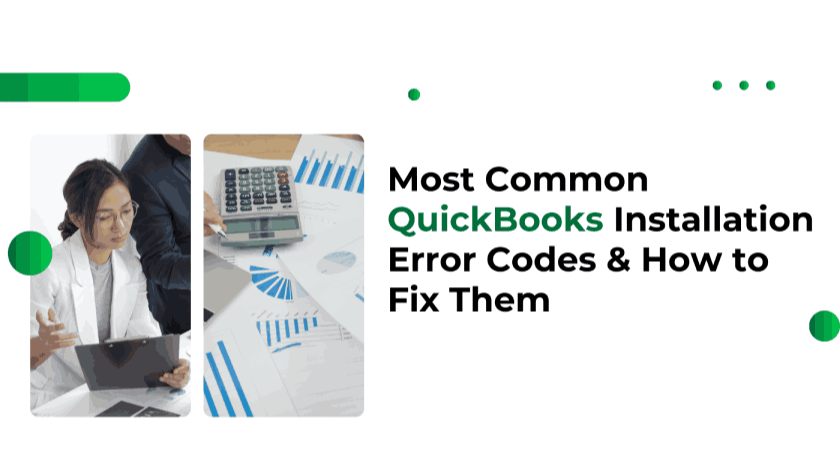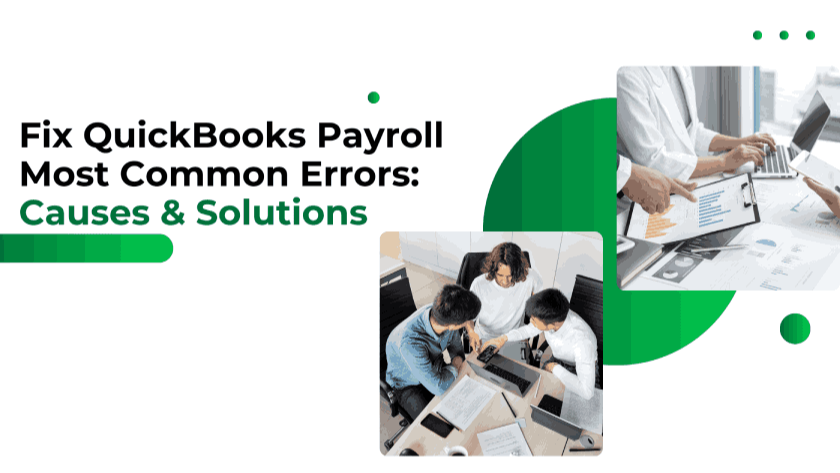If you've encountered QuickBooks Error 1603 while trying to install the software, you're not alone. This error can be frustrating, but with the right steps, it's possible to fix it quickly and get back to work. Here's a guide to help you solve the issue.
What is QuickBooks Error 1603?
QuickBooks Error 1603 appears when you're installing QuickBooks Desktop on a Windows computer. The error message typically states:
“Error 1603: The update installer has encountered an internal error.”
This error generally happens when essential Microsoft components needed for QuickBooks installation, such as .NET Framework, C++, or MSXML, are either missing or damaged. Since QuickBooks relies on these components, any issues with them can trigger Error 1603.
Common Causes of QuickBooks Error 1603
Several factors can contribute to this error, including:
-
Corrupt Installation File: The QuickBooks installer might have been corrupted during the download or installation.
-
Damaged Microsoft Components: Crucial components like .NET Framework, MSXML, or C++ Redistributables could be outdated or broken.
-
Security Settings: Some Windows security policies might block third-party apps, preventing QuickBooks from being installed.
-
Outdated Windows Version: Using an older version of Windows can create compatibility issues.
-
Missing System Updates: Your operating system might not have the necessary updates that QuickBooks needs for installation.
-
Insufficient User Permissions: Installing QuickBooks without administrator rights can trigger this error.
-
Full Temporary Files Folder: A cluttered Temp folder can cause interruptions during installation.
-
Interfering Background Programs: Other applications running on your system might prevent the installation from completing.
Recognizing these causes helps in applying the appropriate solution to fix the issue.
How to Identify QuickBooks Error 1603
You can usually tell when Error 1603 occurs because of:
-
An abrupt stop in the installation process.
-
A message warning that the installation cannot continue.
-
The installer freezing or crashing.
Being aware of these signs can speed up troubleshooting and resolution.
10 Solutions to Fix QuickBooks Error 1603
Here are some effective solutions to help you fix QuickBooks Error 1603:
1. Use QuickBooks Tool Hub
QuickBooks Tool Hub is designed to address various installation problems. Here's how to use it:
-
Download QuickBooks Tool Hub: Visit the official Intuit website to get the latest version (1.4.0.0 or higher).
-
Install the Tool Hub: Open the downloaded file and follow the on-screen instructions.
-
Run the QuickBooks Install Diagnostic Tool: Once installed, open the Tool Hub and navigate to the "Installation Issues" section. Choose "QuickBooks Install Diagnostic Tool" and let it run. The tool will scan and resolve installation problems (this can take up to 20 minutes).
2. Update Windows
Outdated Windows components can interfere with QuickBooks installation. Keep your operating system up to date to prevent conflicts:
-
Check for Windows Updates: Press the Windows key, type “Check for updates” in the search box, and follow the instructions to install any available updates.
-
Restart Your Computer: A restart is required to complete the update process.
After updating, try installing QuickBooks again.
3. Repair Essential Microsoft Components
QuickBooks relies on components like .NET Framework, MSXML, and C++ for installation. If any of these are damaged, you need to repair them:
-
Repair .NET Framework: Go to the Control Panel, then "Programs and Features," and select Microsoft .NET Framework. Right-click and choose "Repair."
-
Repair MSXML and C++: Similarly, find MSXML and C++ in the Programs and Features list and repair them.
If repairs don't work, you can reinstall these components using the QuickBooks installation disc or download them from the official Microsoft website.
4. Use Selective Startup Mode
Some background programs, such as antivirus software, can prevent QuickBooks from installing. Using Selective Startup Mode can bypass this:
-
Launch Selective Startup: Press Windows + R, type “msconfig” and press Enter. In the System Configuration window, choose “Selective Startup” and uncheck "Load startup items."
-
Disable All Non-Microsoft Services: Go to the Services tab, hide all Microsoft services, and disable the rest.
-
Restart and Install: Restart your computer and try installing QuickBooks.
After installation, return to normal startup by selecting “Normal Startup” in the System Configuration window.
5. Verify User Permissions
Ensure your Windows account has administrative privileges to avoid installation errors:
6. Adjust Windows Security Settings
Some Windows policies might block QuickBooks installation. Modify these settings:
-
Modify Security Settings: Press Windows + R, type "gpedit.msc", and press Enter. Navigate to "Windows Installer" under Administrative Templates. Double-click "Prohibit User Installs" and set it to "Not Configured."
7. Install QuickBooks in Safe Mode
Safe Mode disables unnecessary programs that may interfere with installation:
-
Enter Safe Mode: Press Windows + R, type “msconfig,” and ensure “Safe Boot” is selected under the Boot tab. Restart your computer in Safe Mode.
-
Install QuickBooks: Run the QuickBooks installer and complete the installation process.
8. Use the Clean Install Tool
If all else fails, you can perform a clean installation of QuickBooks:
-
Uninstall QuickBooks: Go to Control Panel > Programs and Features, find QuickBooks, and uninstall it.
-
Download the Clean Install Tool: From the QuickBooks Tool Hub, download the Clean Install Tool and follow the instructions to reinstall QuickBooks.
9. Clear the Windows Temp Folder
A full Temp folder can block installation. Here's how to clean it:
-
Delete Temporary Files: Press Windows + R, type “%temp%,” and delete all files in the folder.
-
Restart and Retry Installation: After clearing the folder, restart your computer and attempt to install QuickBooks again.
10. Reinstall QuickBooks Desktop
If nothing else works, uninstall and reinstall QuickBooks to fix any corrupt installation files:
-
Uninstall QuickBooks: Go to Control Panel > Programs and Features, select QuickBooks, and uninstall it.
-
Reinstall QuickBooks: Download the latest version of QuickBooks from the official Intuit website, run the installer as an administrator, and follow the instructions to complete the installation.
When to Seek Professional Help
If none of these solutions fix the issue, it may be time to reach out for professional assistance. Experts can diagnose underlying system issues that might be causing Error 1603. Contact QuickBooks support or a professional IT technician for further help.
Preventing QuickBooks Error 1603 in the Future
To avoid facing this error again:
-
Regularly update Windows.
-
Keep essential Microsoft components repaired.
-
Use the latest version of QuickBooks for better compatibility.
-
Avoid interrupting the installation process by closing unnecessary applications.
QuickBooks Error 1603 is a common issue that can be resolved using the right methods. By following the above solutions, you can install QuickBooks without further complications. If you continue to face issues, don't hesitate to seek professional assistance from QuickBooks support or a trusted IT expert.
Frequently Asked Questions (FAQs)
1. What causes QuickBooks Error 1603?
This error is typically caused by a damaged .NET Framework, outdated Windows, corrupt installation files, or full temporary files.
2. How can I fix QuickBooks Error 1603?
You can resolve the error by running the QuickBooks Install Diagnostic Tool, updating Windows, repairing .NET Framework, or clearing temporary files.
3. Can antivirus software cause Error 1603?
Yes, antivirus software can interfere with the installation process. Temporarily disabling it may help resolve the issue.
 11183 Stone brook Dr. Manassas VA 20112
11183 Stone brook Dr. Manassas VA 20112
 Mon-Fri : 09:30 Am - 06:24 Pm
Mon-Fri : 09:30 Am - 06:24 Pm





